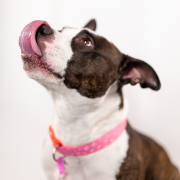Written by Marketing Volunteer, Jane Hillhouse
Did you know February is National Pet Dental Health Care Month? It’s the perfect time to offer the reminder that our pet’s dental health is just as essential as our own. Maintaining your pet’s oral hygiene is an important preventative measure that heads off bad breath, tooth loss, oral pain, and other health conditions caused by worsening dental disease. Many dental issues in pets go unnoticed, so we would like to share signs that your pet might display if they are struggling with dental issues, and to provide a few tips to keep your pet’s teeth clean.
What to Watch for in Dogs and Cats:
The American Veterinary Dental Society reports that 80 percent of dogs and 70 percent of cats show signs of oral disease by age three. Signs of oral disease in dogs and cats include:
- A distinct and unpleasant odor: your pet’s breath might not naturally be the greatest smell in the world, but abnormally bad breath can be a sign of infection.
- Red and inflamed gums (healthy gums are pale pink): gingivitis is the earliest stage of gum disease and takes place when plaque and bacteria build up on our teeth and cause infection, ultimately leading to tooth loss, bone degeneration, and other issues.
- Brown or yellow teeth covered in tartar: similar to how humans get plaque on their teeth from food, animals can get it too; it can lead to gingivitis and tooth loss.
- Loss of appetite: infected teeth can be painful for your pet, so breaking up and chewing food might be difficult for them.
Watch out for these signs by keeping an eye on your pet’s eating habits and frequently taking a peek into their mouth to check their gums and teeth..
Preventative Care for Dogs and Cats Teeth:
It’s recommended that dogs and cats visit their veterinarian for an annual dental check-up, but in the meantime, there are preventative actions you can take at home. One of the biggest struggles in maintaining pets’ oral hygiene at home is their tolerance level. For most pets, a toothbrush is a foreign object that they won’t tolerate at first. If you have a puppy or a kitten, it’s best to familiarize them at a young age. If your pet is older, however, patience, persistence, and positive reinforcement are key.
It’s suggested to clean your cat’s and dog’s teeth at least once or twice a week. To do this, you should start by making your pet comfortable and easing into the process. Allow your pet to sniff and lick the toothbrush, rewarding them with treats and praise before attempting to brush their teeth. Then, once they seem ready, use an adaptable brush that goes over your finger, or a pet-specific toothbrush and toothpaste, to gently brush their teeth. Make sure to focus on the gum lines and the back molars as this is where most plaque and tartar build-up. At first, be sure to keep sessions short and gentle. Incorporating daily dental chews and dental-friendly diets can help between brushings. Be sure to speak with your veterinarian about dental health solutions that are best for your pet.
What to Watch for in Small Mammals:
Small mammals differ slightly from dogs and cats when it comes to dental health. Rabbits and rodents have open-rooted teeth, which means their teeth grow continuously throughout their life. Rabbits, in particular, have easily visible incisors (front teeth) plus molars in the back of the mouth for grinding and chewing. A normal rabbit’s incisors will grow 10-12 cm a year, while guinea pig and chinchilla incisors can grow 5-7.5 cm a year!
One of the most common dental issues in small mammals is Malocclusion, when the top and bottom teeth are misaligned. This can result in improper tooth wear and overgrowth of the incisors or molars. Other signs of poor dental hygiene in small mammals include:
- Overgrown points or sharp spikes that form on the edges of teeth: these spikes can cut and badly damage the tongue, cheeks, or gums.
- Pain when chewing: as teeth grow and are not worn down, they become impacted in the upper and lower jaws, just like impacted wisdom teeth in people. This can cause pain when eating and create sores in the mouth.
Preventative Care for Small Mammals:
Because small mammals like rodents and rabbits have open-rooted teeth, there is no need for brushing. Chewing on a daily diet of hay and greens will wear their teeth down naturally. Always start by monitoring their teeth early on as it will prevent dental issues in the future. Monitoring your pet’s teeth for overgrown incisors is important and the teeth may have to be shortened by a veterinarian. This usually needs to be done regularly, every few weeks to months, as the teeth continue growing. It’s also beneficial to feed your rabbit a diet consisting mainly of high-fiber hay, with smaller amounts of pellets and fresh produce, so that they chew their food constantly and wear down their teeth in the process.
Whether you’ve got a cat, dog, or small mammal, dental care is the cornerstone of a healthy, happy pet! This February, as part of National Pet Dental Health Care Month, take the opportunity to build new habits around your pet’s oral hygiene, and enjoy seeing those pearly whites all year-round!





